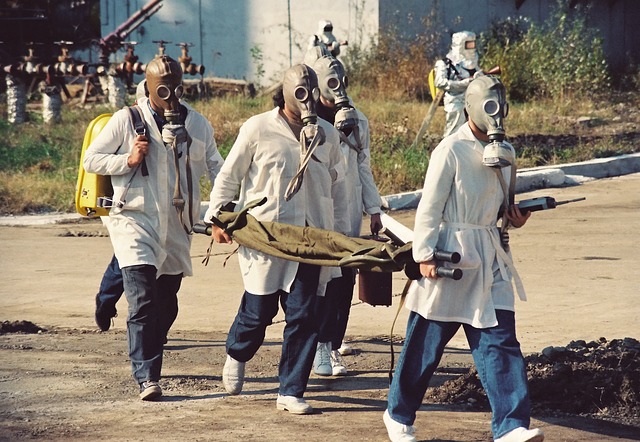In today's competitive landscape, fire departments strive for operational readiness while managing limited budgets. Economical fire training units (EFTUs) emerge as a revolutionary solution, offering immersive, budget-conscious simulator technologies that replicate real-world scenarios. EFTUs provide customizable, versatile scenarios through advanced features like AI and computer-generated environments, ensuring tailored training for specific needs. By investing in these cost-efficient tools, fire services can maximize resource utilization, enhance preparation, and improve community safety without financial burden. Their effectiveness is evident across diverse settings, from rural to urban rescue teams, demonstrating improved response times and coordination through affordable simulation systems. The future of fire training leans towards digital, cost-effective solutions with EFTUs leveraging VR/AR for modular, reconfigurable environments and cloud-based platforms for data analytics and remote monitoring.
In today’s budget-conscious climate, fire departments worldwide are seeking cost-effective solutions for realistic training. This article explores the growing demand for economical fire training units and delves into how these budget-minded simulators offer a game-changing approach to emergency preparedness. By examining key features, benefits, and successful case studies, we uncover why investing in realistic training drills on a limited budget is a strategic move for fire services. Prepare to discover innovative ways to enhance training without breaking the bank.
- Understanding the Need for Economical Fire Training Solutions
- Key Features of an Efficient Budget-Minded Simulator
- Benefits of Implementing Realistic Training Drills on a Limited Budget
- Case Studies: Successful Deployments in Various Settings
- Future Trends and Innovations in Economical Fire Training Units
Understanding the Need for Economical Fire Training Solutions

In today’s competitive landscape, fire departments and emergency services are constantly seeking cost-effective solutions to enhance their operational readiness without straining budgets. Traditional fire training methods, while essential, can be resource-intensive and expensive, making it challenging for smaller departments or those with limited funding to keep up with the latest equipment and scenarios. This is where the concept of economical fire training units gains prominence. By leveraging innovative, budget-minded simulator technologies, fire fighters can participate in realistic drills without incurring the hefty costs associated with full-scale training facilities.
These economical fire training solutions offer a practical approach, enabling departments to simulate various emergency situations and refine response strategies. With customizable scenarios and modular designs, these units provide flexibility, ensuring that training stays relevant and tailored to specific needs. By investing in such cost-efficient training tools, fire services can maximize their resources, foster better preparation, and ultimately improve community safety without breaking the bank.
Key Features of an Efficient Budget-Minded Simulator

In today’s digital era, budget-conscious organizations are seeking innovative solutions for realistic training drills without breaking the bank. An efficient budget-minded simulator, such as an economical fire training unit, should offer a range of key features to ensure maximum value and effectiveness. First and foremost, it must provide immersive simulations that accurately replicate real-world scenarios, enabling trainees to gain practical experience in a safe and controlled environment.
These simulators should be versatile, adaptable to various training needs, and capable of generating diverse scenarios. Advanced technologies like AI and computer-generated environments can enhance the realism and customization options. Additionally, user-friendly interfaces and intuitive controls are essential for minimizing training time and maximizing engagement. Cost-effectiveness should also be a core feature, achieved through modular design, customizable hardware, and software updates that extend the simulator’s lifespan without significant investment.
Benefits of Implementing Realistic Training Drills on a Limited Budget

Implementing realistic training drills doesn’t always require a substantial budget. Even with limited resources, organizations can significantly enhance their training programs through strategic investments in economical fire training units and simulations. These cost-effective solutions enable firefighters to gain invaluable experience in controlled, risk-free environments, fostering better decision-making skills and improving overall performance during actual emergencies.
Realistic drills on a tight budget offer numerous advantages, including improved crew coordination, enhanced situational awareness, and reduced risk of injury or property damage. By focusing on high-fidelity simulations tailored to specific scenarios, departments can maximize training outcomes while minimizing financial strain. This approach ensures that firefighters are prepared for a wide range of challenges, ultimately leading to better response times and more effective incident management.
Case Studies: Successful Deployments in Various Settings

In various settings, from rural fire departments to urban rescue teams, the implementation of economical fire training units has proven transformative. These budget-minded simulators have enabled organizations to conduct realistic drills without breaking the bank, a significant advantage for cash-strapped departments. For instance, a small-town fire station successfully utilized an affordable simulation system to replicate complex scenarios, enhancing their response times and team coordination. This case study highlights how investing in such technology can significantly improve emergency preparedness without requiring substantial financial resources.
Another successful deployment was observed in a metropolitan area where a large rescue operation relied on the versatility of economical fire training units. The modular design allowed for adaptable setups, catering to both indoor and outdoor training needs. By simulating diverse environments, rescuers honed their skills in various conditions, leading to more effective operations during actual crises. These examples demonstrate that even with limited funds, organizations can access powerful tools to elevate their training regimen and ultimately save lives.
Future Trends and Innovations in Economical Fire Training Units

The future of fire training is looking increasingly digital and affordable, with a growing demand for realistic simulations that don’t break the bank. Economical fire training units are gaining traction as organizations seek cost-effective alternatives to traditional high-end simulators. These innovative solutions leverage advanced technologies like virtual reality (VR), augmented reality (AR), and 3D modeling to create immersive scenarios without significant investment.
One trend to watch is the integration of modular, reconfigurable environments that allow for diverse training situations. These versatile units can be easily adapted to various settings, from urban structures to industrial facilities, enabling firefighters to prepare for a wide range of emergency responses. Additionally, cloud-based platforms and data analytics are enhancing these simulations by providing performance metrics and allowing for remote monitoring and scenario adjustments in real time, ensuring continuous learning and improvement in fire training efficiency.






